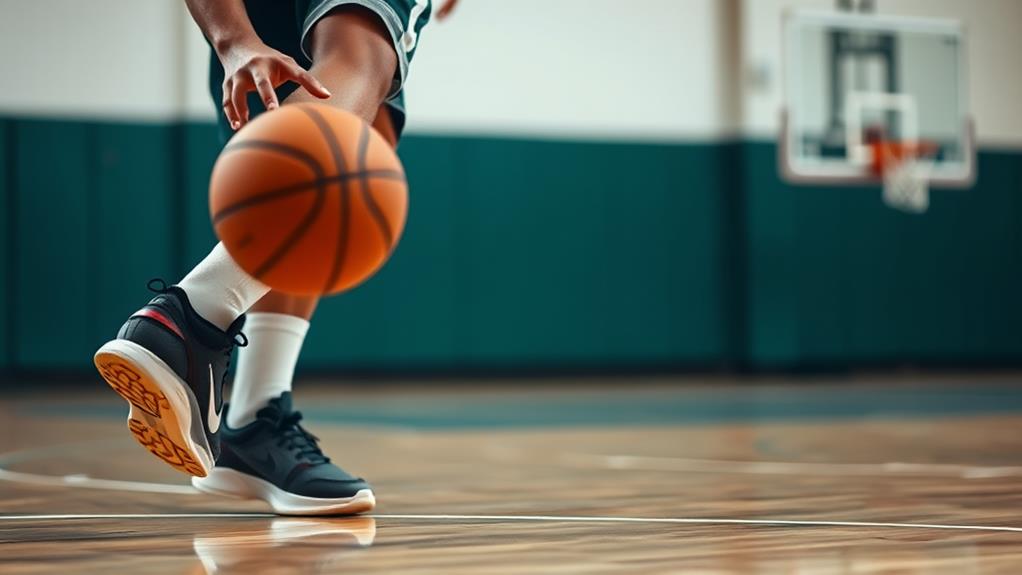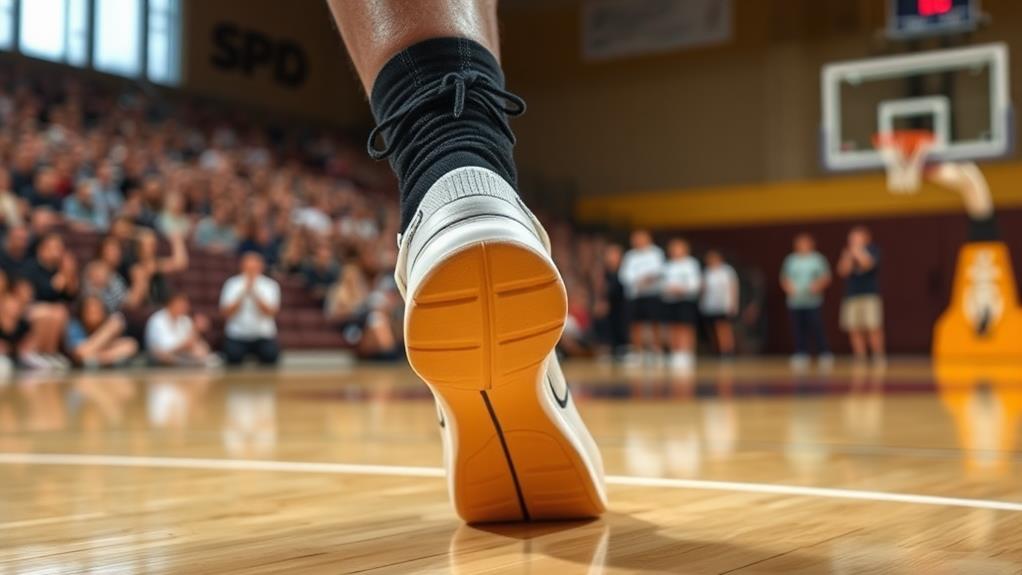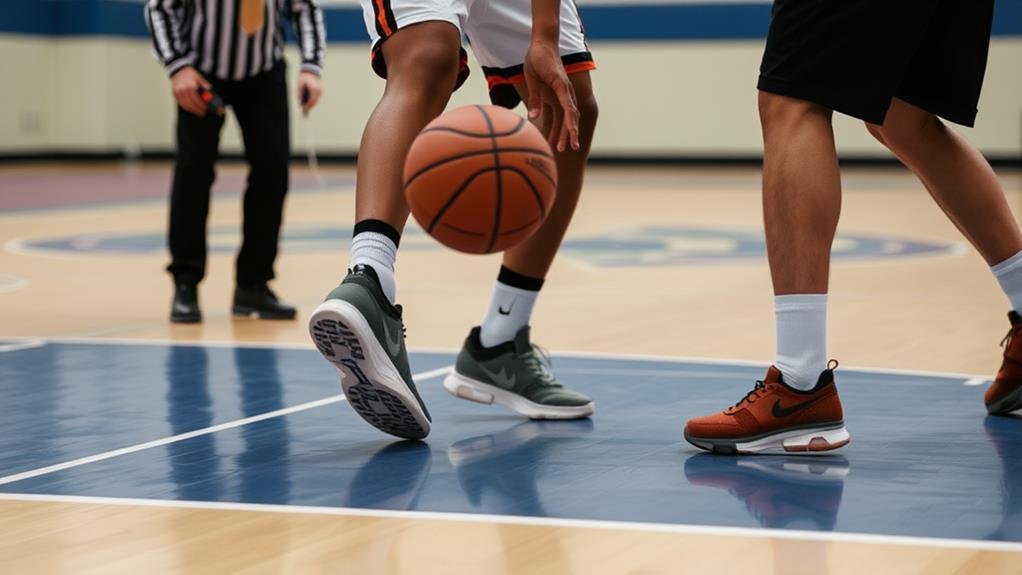
What Is Traveling in Basketball? How to Avoid It
October 11, 2024Traveling in basketball happens when you take more than two steps without dribbling, which leads to a turnover. To avoid this, always establish a pivot foot and be aware of your foot movements. After gathering the ball, you can take one additional step legally, known as the gather step. Be careful not to lift your pivot foot before dribbling or to change it without a dribble; both are violations. Practicing footwork drills can help you master these techniques and keep your game strong. There's much more to uncover about effective footwork techniques and strategies.
Definition of Traveling
In basketball, traveling refers to the illegal movement of a player's feet while holding the ball. The definition of traveling centers on a player taking more than two steps without dribbling, shooting, or passing. If you're a player holding the ball, you need to be mindful of the traveling rules to avoid committing a violation.
In the NBA, you can take two steps after the gather step, but this can lead to confusion. Unlike the NBA, the NCAA and NFHS have stricter interpretations, where you can't move a foot or both feet beyond prescribed limits after receiving the ball.
Establishing a pivot foot is essential when you've stopped dribbling. If you lift that pivot foot and take additional steps, it results in a traveling violation, leading to a turnover. This means the opposing team gains possession, disrupting your team's rhythm.
To avoid traveling violations, always be aware of your steps and foot placement. Understanding the nuances of the traveling rules, including how to properly execute a gather step, can keep you in the game and maintain your team's momentum.
Common Traveling Scenarios
Understanding the traveling rules is essential for players to avoid common mistakes on the court. One frequent traveling violation occurs when you take more than two steps after picking up your dribble, leading to a loss of possession. It's important to establish your pivot foot properly; shuffling your feet before dribbling can easily result in a call.
Remember, once you choose a pivot foot, you can't change it without dribbling the ball. Utilizing data analytics can also provide insights into player movements and help in refining footwork to minimize violations.
Another common mistake is taking three steps before dribbling after receiving a pass while running. This is a violation, and understanding this rule can help you stay in the game. Basketball players often struggle with footwork, so practicing how to move effectively while maintaining control is essential.
Additionally, players might confuse the gather step with traveling. While the gather step allows for an extra step after collecting the ball, players must be careful not to take more than that.
Understanding the Gather Step

The gather step is a game-changer when it comes to your footwork in basketball. It allows you to take an extra step after gathering the ball, which can enhance your offensive plays and help you avoid traveling violations.
Understanding this rule is key to improving your gameplay and clearing up any common misunderstandings. As the game evolves, defensive strategies also adapt, emphasizing the need for offensive players to be aware of their footwork to maintain an edge against strong analytics-driven defensive schemes.
Mastering the gather step can greatly impact your ability to navigate these increasingly complex defensive setups.
Gather Step Definition
When a player gathers the ball, they gain an important advantage: the gather step. This vital aspect of the NBA rulebook allows you to take an additional step after securing the ball, providing more freedom to move without being called for a traveling violation. The first step you take upon gathering the ball is considered part of the gather step and doesn't count against your total allowed steps before a traveling violation is called.
Understanding the gather step is essential for maximizing your scoring opportunities and enhancing your overall effectiveness on the court. It allows for smoother shifts between dribbling, shooting, and passing, minimizing the risk of committing a traveling violation. Mastering this technique not only benefits individual players but also helps coaches develop better strategies during gameplay.
To effectively use the gather step, focus on your footwork techniques, ensuring you establish your pivot foot correctly. With practice, you'll become adept at utilizing this movement allowed, allowing you to navigate around defenders and create better chances to score.
For players and coaches alike, skill development in this area can greatly impact performance in offensive situations.
Importance in Gameplay
Mastering the gather step can really elevate your gameplay by giving you the freedom to maneuver more effectively on the court. Understanding this step is essential for players looking to enhance their offensive strategies while adhering to the traveling rule.
When you execute the gather step correctly, you can take two steps after gathering the ball, which allows for:
- Dynamic drives toward the basket
- Creating space for a shot
- Utilizing proper footwork to maintain balance
Players must focus on their pivot foot and how it interacts with the gather step to avoid traveling violations. This skill involves knowing how to position your body and feet to maximize your movements without breaking the rules.
The gather step adds an extra layer of flexibility, enabling you to be more creative in your plays.
Common Misunderstandings
Many players struggle with the gather step, often mistaking it for a traveling violation due to its nuances. Under NBA rules, the gather step—also known as the zero step—occurs right before your first official step after gaining possession of the ball. This extra step doesn't count against you regarding traveling, but it can create misunderstandings.
When you shift from a dribble to a shot or pass, it's easy to misinterpret your footwork as traveling. Coaches need to clarify that the gather step is a legal maneuver that enhances your offensive play without risking a traveling violation. Understanding this concept is vital for improving your gameplay efficiency.
To avoid confusion, practice your footwork during drills. Be aware that your pivot foot remains essential, but the gather step allows you some leeway in movement.
History of the Traveling Rule
The traveling rule's evolution has shaped how you play the game today. As the regulations tightened over the years, the dynamics of gameplay changed markedly, impacting strategies and player movements.
Racial integration in basketball has also influenced the style of play, as increased diversity in athletic representation brought unique skills and approaches to the court.
Understanding this history helps you appreciate the nuances of modern basketball and the importance of consistent rule enforcement.
Rule Evolution Over Time
Basketball's traveling rule has undergone significant transformations since the sport's early days. Initially, the game lacked clear movement regulations, leaving much to referees' judgment. However, key rule changes, particularly with the introduction of dribbling by the Yale University basketball team in 1897, established guidelines for foot movement, including how to properly use a pivot foot.
The evolution of the traveling rule in basketball can be highlighted through these key points:
- Early games relied heavily on subjective officiating, making it difficult to enforce traveling violations.
- The NBA and FIBA now define traveling as taking more than two steps without dribbling, while NCAA and NFHS have a stricter stance.
- FIBA clarified the rule in 2018 by introducing the gather step, allowing an additional step after gathering the ball.
These historical changes reflect the ongoing adjustments in officiating and gameplay style, aiming to enhance the sport's integrity and fairness.
Understanding these developments helps you appreciate how the traveling rule has shaped the game and how to avoid violations on the court.
Impact on Gameplay Dynamics
Traveling's impact on gameplay dynamics is profound, shaping how players approach movement on the court. As the rules in basketball have evolved, so has the understanding of what constitutes a traveling violation.
With the introduction of dribbling in 1897, the game gained structure, requiring players to be more aware of their pivot foot and the steps they take while handling the ball.
The recent addition of the gather step in 2018 allowed players to take an extra step after gaining possession, adjusting the enforcement of the traveling rule. This change impacts gameplay by encouraging more fluid player movement while reducing turnovers.
However, variations in enforcement across leagues like the NBA, NCAA, and FIBA create different gameplay dynamics. NBA referees may allow more leeway, while NCAA and NFHS officials often call stricter violations.
Ultimately, the evolution of the traveling rule promotes fair play, ensuring players adapt their strategies to stay within the confines of the game.
Referee Guidelines for Traveling

Referees play an essential role in maintaining the flow of the game by closely monitoring players' foot movements, especially regarding the pivot foot and step count.
Understanding the referee guidelines for traveling is critical for players to avoid violations that can disrupt game momentum. Mastering the rules surrounding traveling can provide a strategic advantage in fast-paced competitions.
Here are some key points referees consider:
- Gather Step: In the NBA, players can take a gather step, which counts as one of their two allowed steps after receiving the ball.
- Pivot Foot: If a player lifts their pivot foot before dribbling, it results in a traveling violation.
- Step Count: Players mustn't exceed the permitted steps without dribbling, passing, or shooting.
Referees need to rely on split-second judgment to identify traveling.
With different interpretations between leagues like NCAA and FIBA, consistency is essential. Clear communication and ongoing education about rule changes guarantee referees apply the rules fairly and accurately.
Techniques to Avoid Violations
Often, players overlook the importance of mastering footwork techniques to avoid traveling violations. One key technique is the jump stop, where you land on both feet simultaneously. This establishes a pivot foot and helps you maintain control of your steps.
Practicing the Euro step is another effective way to enhance your footwork. It allows you to take two distinct steps in different directions without incurring a traveling call. To further develop your skills, engaging in footwork drills can greatly improve your agility and precision on the court.
Incorporating footwork drills into your training regimen is vital. Focus on quick pivots and maintaining a low stance to reduce the risk of traveling violations during games.
Agility is essential, so include ladder drills to improve your foot coordination. This will help you develop better awareness of your steps while handling the ball.
Conclusion
In basketball, avoiding traveling can feel like trying to dodge a speeding train. By understanding the gather step and familiarizing yourself with common scenarios, you can keep your game sharp. Remember, the key is to stay aware of your footwork and maintain control. Just like a seasoned player wouldn't take a last-minute shot without evaluating the court, you shouldn't overlook the importance of proper movement. Master these techniques, and you'll be dribbling past violations like a pro!


